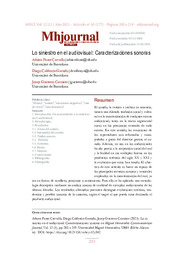Por favor, use este identificador para citar o enlazar este ítem:
https://hdl.handle.net/11000/26372Registro completo de metadatos
| Campo DC | Valor | Lengua/Idioma |
|---|---|---|
| dc.contributor.author | Faure Carvallo, Adrien | - |
| dc.contributor.author | Calderón Garrido, Diego | - |
| dc.contributor.author | Gustems Carnicer, Josep | - |
| dc.date.accessioned | 2022-03-28T09:10:53Z | - |
| dc.date.available | 2022-03-28T09:10:53Z | - |
| dc.date.created | 2021-01-31 | - |
| dc.identifier.citation | Vol.12 (2021) | es_ES |
| dc.identifier.issn | 1989-8681 | - |
| dc.identifier.uri | http://hdl.handle.net/11000/26372 | - |
| dc.description.abstract | El sonido, la música e incluso su ausencia, tienen una dilatada tradición social y cultu-ral en la caracterización de cualquier escena audiovisual, tanto en la trama argumental como en los personajes centrales de cada escena. En este sentido, las emociones de los espectadores son reforzadas y mani-puladas a gusto del director gracias al so-nido. Además, su uso en los audiovisuales ha ido parejo a la aceptación social del mal y la fealdad en sus múltiples facetas en los productos estéticos del siglo XX y XXI y la evolución que estos han tenido. El obje-tivo de este artículo es hacer un repaso de los principales recursos sonoros y musicales empleados en la caracterización del mal, ya sea en forma de conflicto, personaje o sentimiento. Para ello se ha aplicado una metodo-logía descriptiva mediante un análisis sonoro de multitud de ejemplos audiovisuales de las últimas décadas. Los resultados obtenidos permiten distinguir evoluciones estéticas, ten-dencias y perfiles sonoros de lo siniestro, según el target al que pueda estar destinado el producto audiovisual. | es_ES |
| dc.description.abstract | Sound, music and even its absence have a long social and cultural tradition in the characterization of any audiovisual scene, both in the plot and in the central charac-ters of each scene. In this sense, the emo-tions of the spectators are reinforced and manipulated as the director likes thanks to the sound. In addition, its use in audio-visuals has gone hand in hand with the social acceptance of evil and ugliness in its many facets in the aesthetic products of the 20th and 21st centuries and the evolution that these have had. The aim of this article is to review the main sound and musical resources used to character-ize evil, whether in the form of conflict, character or feeling. A descriptive method is applied through a sound analysis of a multitude of audiovisual examples from the last decades. The results obtained allow us to distinguish aesthetic developments, trends and sound profiles from the sinister, according to the target for which the audiovisual product may be intended | es_ES |
| dc.format | application/pdf | es_ES |
| dc.format.extent | 17 | es_ES |
| dc.language.iso | spa | es_ES |
| dc.publisher | Universidad Miguel Hernández de Elche | es_ES |
| dc.rights | info:eu-repo/semantics/openAccess | es_ES |
| dc.rights | Attribution-NonCommercial-NoDerivatives 4.0 Internacional | * |
| dc.rights.uri | http://creativecommons.org/licenses/by-nc-nd/4.0/ | * |
| dc.subject | Música | es_ES |
| dc.subject | sonido | es_ES |
| dc.subject | emociones negativas | es_ES |
| dc.subject | cine de terror | es_ES |
| dc.subject | cine fantástico | es_ES |
| dc.subject.other | CDU::3 - Ciencias sociales | es_ES |
| dc.title | Lo siniestro en el audiovisual: Caracterizaciones sonoras | es_ES |
| dc.title.alternative | The sinister in the audiovisual: Sound characterizations | es_ES |
| dc.type | info:eu-repo/semantics/article | es_ES |
| dc.identifier.doi | 10.21134/mhcj.v12i.942 | - |
| dc.relation.publisherversion | https://doi.org/10.21134/mhcj.v12i.942 | - |

Ver/Abrir:
942-Texto del artículo-5274-2-10-20210131.pdf
484,97 kB
Adobe PDF
Compartir:
 La licencia se describe como: Atribución-NonComercial-NoDerivada 4.0 Internacional.
La licencia se describe como: Atribución-NonComercial-NoDerivada 4.0 Internacional.
.png)